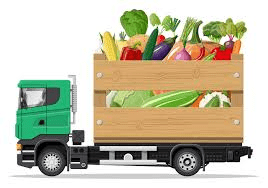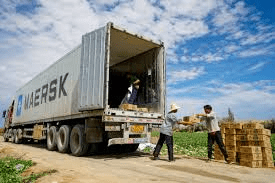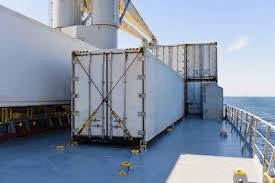Stacking patterns in transport vehicles should minimize contact between the fresh farm produce and the floor and wall surfaces of the vehicle to reduce the transmission of heat from the outside of the vehicle into the loaded produce.
Centre-loading leaves an insulating air space between the load and the outside walls of the vehicle. Produce transported in cartons should be stacked to allow adequate air circulation throughout the load.
The industry norm is to load palletized fruit, i.e. fruit in cartons placed on a pallet. Palletisation makes loading easier and more cost effective than loading loose cartons into the container.
Palletizing is usually done after other pre-cooling methods, but before forced air- cooling. Pallets must, however, be properly secured by strapping, corner bracing or net wrapping.
1. Build- up of Gases in the Transport System
Inadequate air circulation during the transportation of fresh produce can lead to the build- up of ethylene or carbon dioxide.
Care must therefore be taken to assure proper ventilation within the transportation vehicle in order to avoid gas build up.
a) Transportation of mixed loads
Mixed loads can be of serious concern when temperature optima are not compatible or when ethylene-producing commodities and ethylene-sensitive commodities are transported together.
Wet and dry produce items must be transported in separate mixed loads in order to avoid the transfer of contamination from wet to dry produce.
2. Hygiene in Transport Systems
The quality of perishable produce can be adversely affected by a lack of standard hygiene in transportation systems. Soil, typically found in a field, can encrust the floor area of the transport system.
In order to prevent contamination by food-borne pathogens, transport systems should make use of good sanitation practices, ensure proper temperature and humidity management and minimize potential damage to the produce.
It is critical that all vehicles used for transportation of food products are cleaned and washed routinely to remove decaying remains of agricultural produce. Water, used for washing, must be safe and clean.
Read Also : Seed Germination and Dormancy to Plant Growth and Development
If pallets are cleaned by fumigation, only recommended/permitted fumigants or chemicals must be used and such use must be according to the manufacturers recommendations.
Factors that Govern the Selection of the Mode of Transportation

The mode of transportation is influenced by:
- The destination of the produce
- The value of the produce
- The degree of perishability
- The volume of produce to be transported
- Recommended storage temperature and relative humidity conditions for the load
- Ambient temperature conditions at origin and destination points
- Time in transit to reach the destination by air, land or sea transport
- Road access
- Freight rates
- Quality of the transportation service
Transport Equipment
Equipment used for the transport of fresh produce includes:
- Refrigerated and non-refrigerated vehicles – for highway transport
- Containers for air, rail and highway transport, and for lift-on/lift-off ocean transport
- Break bulk refrigerated vessels – for handling palletized loads in the refrigerated holds of vessels
- Pallets – for air cargo and highway transport
- Horse carts, donkeys
- Wheelbarrows and carts – for transportation over distances of 1-8km
- Refrigerated or non-refrigerated vehicles can be used for the bulk transportation of fresh produce.
- Refrigerated and non-refrigerated vehicles
Non-refrigerated Vehicles

Non-refrigerated vehicles must provide sufficient cooling of the produce during transport. The load should be covered with a white/light-colored canvas to avoid overheating and to allow adequate air circulation throughout the produce.
A truck-ventilating device, can be used to facilitate airflow in non-refrigerated trucks consists of wind catchers and ducts, which are constructed using wooden crates or galvanized iron. The open-ended crates are wired together into a sturdy pattern.
Air flows upwards through the load during transport, so avoiding extensive overheating of the produce. Best results can be obtained if produce is transported during the early morning hours before sunrise.
Refrigerated Trailers
Refrigerated vehicles/trailers must be properly insulated, have a high-capacity refrigeration unit and fan and an air-delivery duct.
The vehicle should be well insulated to maintain a cool environment for pre-cooled commodities and adequately ventilated to allow air movement through the produce.
Containers
Containers are insulated metal boxes that are designed for the transport of large volumes of produce over long distances.
They are generally equipped with thermometers and/or data loggers, which measure discharge air temperature at their specific locations and provide performance records of the operation of the refrigeration unit.
Read Also : Guideline to Proper Animal Feed Storage and Methods
Refrigerated Containers
Refrigerated or reefer containers are generally equipped with a cooling unit, and require an external source of electricity to power the cooling unit and air circulation fans. Reefer containers are available in both 6.1 m and12.2 m lengths.
The 12.2 m reefer container is the most commonly used in the fruit export industry worldwide. The 6.1 m container is generally considered a relatively expensive option when compared to the 12.2m container.
Modern containers incorporate microprocessors and computers for controlling the refrigeration system. The 40-foot standard container can usually accommodate 20 ISO (International Organization of Standardization) pallets, while the 20-footer can accommodate nine pallets.
Porthole Containers

Porthole containers are insulated containers in which cold air is supplied by an external cooler at the required temperature.
The warm air within the porthole container is extracted from the top of the load. Air flows to and from the porthole container via vents or portholes.
Controlled Atmosphere (CA) Containers
Controlled atmosphere containers are designed to maintain the composition of the storage atmosphere around fruits within the container
Categories of CA containers:
Refrigerated – here the containers are fitted with special equipment to maintain controlled atmosphere (CA) conditions.
Add-on – here containers have the basic controls fitted in the refrigeration unit, but require the addition of gas and chemicals to establish and maintain CA conditions.
Central system containers – these containers have basic fittings that need to be connected to a central plant on board the ship to establish and maintain CA conditions.
Break Bulk Refrigerated Vessels

Break bulk refrigerated vessels consist of a number of cold rooms, which can accommodate palletized produce. Between 140 and 400 pallets per cold room can be accommodated in break bulk refrigerated vessels.
Palletization
The palletization of produce facilitates handling during shipping. Palletization reduces damage to produce and increases the efficiency of loading and unloading operations.
Plastic netting of palletized loads helps in preventing vibration and impact damage to the produce during transit.
Read Also : Indomie: Instant Noodle – Recipes, Nutrition and Health Benefits
Frequently Asked Questions
We will update this section soon.
